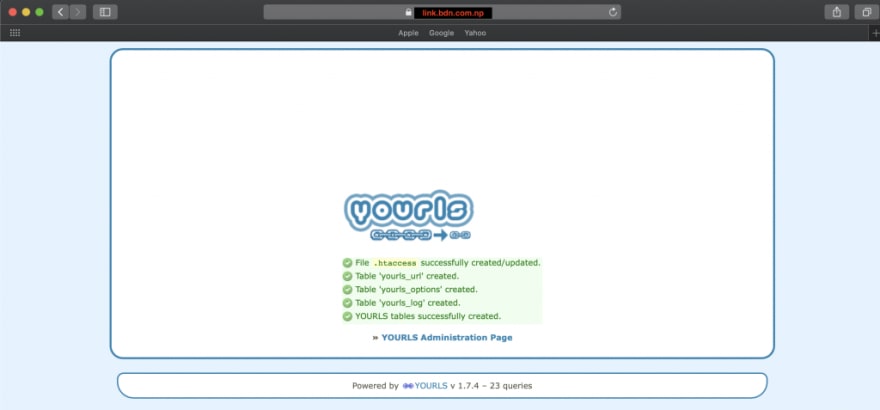
Bidhan Khatri
Posted on April 25, 2020
In this guide, I will explain how to install YOURLS on a Centos7 VPS with MariaDB 10.4, PHP 7.3, and Nginx with HTTPS. YOURLS stands for Your Own URL Shortener. YOURLS is an open-source self-hosted application build with PHP which allows you to run your own URL shortening service.
Also, check yourls.org! Learn more tweaks in the Wiki documentation.
First Download the latest stable version MariaDB 10.4 on centos 7.
cat <<EOF | sudo tee -a /etc/yum.repos.d/MariaDB.repo
# MariaDB 10.4 CentOS repository list - created 2020-01-03 16:44 UTC
# http://downloads.mariadb.org/mariadb/repositories/
[mariadb]
name = MariaDB
baseurl = http://yum.mariadb.org/10.4/centos7-amd64
gpgkey=https://yum.mariadb.org/RPM-GPG-KEY-MariaDB
gpgcheck=1
EOF
yum install MariaDB-server
systemctl start mariadb
systemctl enable mariadb
Once the database server is installed, execute the ‘mysql_secure_installation’ post-installation script to set your MySQL root password and secure the server.
mysql_secure_connection
Login to MySQL shell as root and configure the database.
mysql -u root -p
MariaDB [(none)]> CREATE DATABASE yourlsdb;
MariaDB [(none)]> GRANT ALL PRIVILEGES ON yourlsdb.* TO ‘username’@‘localhost' IDENTIFIED BY ‘password’;
MariaDB [(none)]> FLUSH PRIVILEGES;
MariaDB [(none)]> exit
Now Install PHP 7.3 and require modules.
yum install epel-release yum-utils
yum install http://rpms.remirepo.net/enterprise/remi-release-7.rpm
yum-config-manager --enable remi-php73
yum install php php-common php-opcache php-mcrypt php-cli php-gd php-curl php-mysqlnd php-fpm
php -v
Configure PHP-FPM:
Create a new PHP-FPM pool for yourls.
vim /etc/php-fpm.d/yourls.conf
[yourls]
listen = /var/run/php-fpm/php-fpm.sock
listen.allowed_clients = 127.0.0.1
listen.owner = nginx
listen.group = nginx
listen.mode = 0666
user = nginx
group = nginx
pm = ondemand
pm.max_children = 50
pm.start_servers = 5
pm.min_spare_servers = 5
pm.max_spare_servers = 35
security.limit_extensions = .php .php3 .php4 .php5
php_admin_value[error_log] = /var/log/php-fpm/www-error.log
Now Restart PHP-FPM
systemctl restart php-fpm
Now Install and configure YOURLS.
yum install git
cd /var/www/html/
git clone https://github.com/YOURLS/YOURLS.git
chown -R nginx: /var/www/html/YOURLS
mv /var/www/html/YOURLS/user/config-sample.php /var/www/html/YOURLS/user/config.php
vim /var/www/html/YOURLS/user/config.php
(Replace below lines according to your configuration.)
/** MySQL database username */
define( 'YOURLS_DB_USER', 'username' );
/** MySQL database password */
define( 'YOURLS_DB_PASS', 'password' );
/** The name of the database for YOURLS */
define( 'YOURLS_DB_NAME', 'yourlsdb' );
/** MySQL hostname.
define( 'YOURLS_DB_HOST', 'localhost' );
/** MySQL tables prefix */
define( 'YOURLS_DB_PREFIX', 'yourls_' );
define( 'YOURLS_SITE', 'https://link.bdn.com.np’ );
define('YOURLS_ADMIN_SSL', true);
/** A random secret hash used to encrypt cookies. You don't have to remember it, make it long and complicated.
define( 'YOURLS_COOKIEKEY', ‘0101011’01010x0x0x0x0xx0x0x0xx0asadqw23232dsdsd2e22232 );
$yourls_user_passwords = array(
'bdnadmin => ‘password123' /* This credential is used for web login later.*/ ,
// 'username2' => 'password2', // You can have one or more 'login'=>'password' lines
);
Install and configure Nginx:
yum install nginx
vim /etc/nginx/conf.d/link.bdn.com.np.conf
server {
listen 80;
listen [::]:80;
server_name link.bdn.com.np www.link.bdn.com.np;
return 301 https://$host$request_uri;
}
server {
listen 443 ssl;
listen [::]:443 ssl;
server_name link.bdn.com.np www.link.bdn.com.np;
ssl_certificate /etc/nginx/ssl/bundle.crt;
ssl_certificate_key /etc/nginx/ssl/bdncom.np.key;
root /var/www/html/YOURLS;
index index.php index.html index.htm;
access_log /var/log/nginx/link.bdn.com.np_access.log;
error_log /var/log/nginx/link.bdn.com.np_error.log;
index index.php;
# Rewrites
location / {
try_files $uri $uri/ /yourls-loader.php;
expires 14d;
add_header Cache-Control 'public';
}
# PHP Engine
location ~ \.php$ {
fastcgi_split_path_info ^(.+\.php)(/.+)$;
fastcgi_pass unix:/var/run/php-fpm/php-fpm.sock;
fastcgi_index index.php;
include fastcgi_params;
fastcgi_param SCRIPT_FILENAME $document_root$fastcgi_script_name;
fastcgi_intercept_errors off;
fastcgi_buffer_size 16k;
fastcgi_buffers 4 16k;
}
}
Test the Nginx configuration and restart Nginx:
nginx -t
systemctl restart nginx
Final step:
Open** https://link.bdn.com.np/admin/install.php** in your favorite web browser and you should see the YOURLS install screen. Click on the ‘Install YOURLS’ button to populate the database.
Now login to YOURLS Administration Page.
https://link.bdn.com.np/admin
username: bdnadmin
password: password123

Posted on April 25, 2020
Join Our Newsletter. No Spam, Only the good stuff.
Sign up to receive the latest update from our blog.


